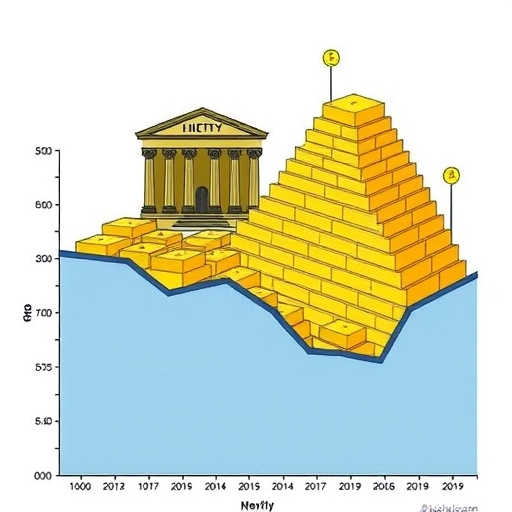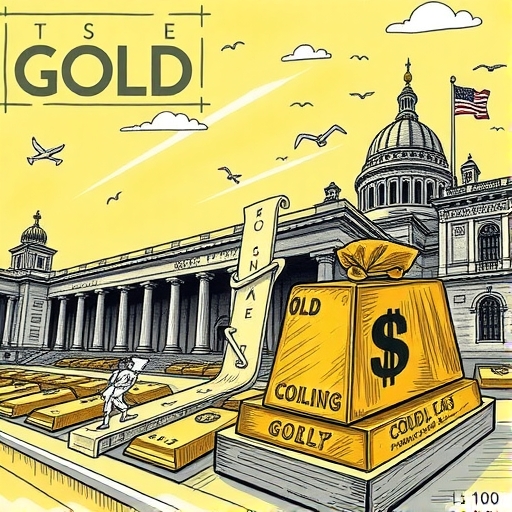The Great Reserve Shift: A Turning Point for Global Finance
Welcome back, fellow travelers on the path to financial mastery. Today, we’re diving deep into a topic that’s generating significant discussion within the world’s most influential financial institutions: a potential tectonic shift in how central banks are managing their vital reserve holdings. Think of central bank reserves like the ultimate rainy-day fund for an entire country, held in various assets to ensure stability and facilitate international transactions. For decades, the US dollar has reigned supreme as the world’s primary reserve currency. Its stability, the depth of US financial markets, and America’s economic dominance made it the default choice. However, recent signals suggest this long-held status quo might be undergoing a fundamental change. We are witnessing a notable increase in the accumulation of gold by central banks around the globe, coupled with a forecasted decline in their US dollar holdings. This isn’t just a minor adjustment; it could signal a foundational challenge to the dollar’s long-held position at the center of global finance. Why is this happening now, and what does it mean for you as a trader or investor?
In summary, key points to consider include:
- Central banks are increasingly shifting reserves from the US dollar to gold.
- This shift may impact the future dominance of the dollar as a global reserve currency.
- Understanding these dynamics is essential for traders and investors alike.
It’s also important to note the various external factors influencing this shift. Economic trends, geopolitical events, and market sentiment all play a role in shaping the decisions of central banks. For instance, the historical performance of gold as a safe-haven asset during times of uncertainty has led to its increased appeal among financial institutions.

Central Banks Are Piling into Gold: Record Accumulation Explained
Let’s start with the shining star of this narrative: gold. You’ve likely seen the headlines about gold prices hitting all-time highs. While various factors contribute to gold’s price movements, one of the most significant, and perhaps least understood by the average observer, is the aggressive buying by central banks. Over the past three years, central bank gold purchases have averaged over 1,000 tonnes annually. To put this into perspective, that’s more than double the average rate seen in the preceding decade. This isn’t speculative trading; this is strategic accumulation on a massive scale. Why are these powerful institutions, guardians of national wealth, suddenly so keen on gold? Several factors are at play:
- Diversification: Relying too heavily on a single asset or currency, even one as dominant as the US dollar, carries concentration risk. Central banks are seeking to spread their risk, and gold, historically uncorrelated with traditional paper currencies and government bonds, offers an attractive alternative.
- Store of Value: In an era of geopolitical uncertainty and potential inflation concerns, gold is often viewed as a reliable store of value, preserving wealth across generations and economic cycles. It’s a tangible asset, not a liability of another government.
- Loss of Trust/Sovereignty Concerns: Recent geopolitical events have highlighted the potential for reserve assets held in other countries to be frozen or sanctioned. Gold held physically within a nation’s borders offers a level of sovereignty and security that electronically held assets in another jurisdiction might not.
This isn’t just a few isolated cases; it’s a broad trend reflecting a shift in global financial strategy. Central banks, from emerging economies to established financial powers, are participating in this gold rush.

World Gold Council Survey Reveals Clear Intentions
To truly grasp the scale and intent behind this shift, we can look to authoritative sources that survey these institutions directly. The World Gold Council, a reputable organization tracking the gold market, conducts an annual survey of central banks regarding their reserve management intentions and perceptions. The results from their latest survey are striking and provide a clear window into the collective thinking of the world’s monetary authorities.
Key findings reveal a strong consensus: a staggering 95% of central banks surveyed expect global gold reserves to rise in the next 12 months. Furthermore, a significant minority, 43%, explicitly plan to increase their own gold holdings over the same period. This isn’t mere speculation; these are stated intentions from the very institutions driving the trend. This data underscores the strategic importance central banks are now placing on gold as a core component of their reserves.
What does this level of consensus tell us? It suggests that the factors driving gold accumulation are deeply embedded in current macroeconomic and geopolitical realities, not just transient market noise. It reflects a fundamental reassessment of risk and the future shape of the global financial system.
The Forecast: Central Banks Expect Significant US Dollar Decline
Now, let’s examine the flip side of the reserve coin: the US dollar. The World Gold Council survey didn’t just focus on gold; it also probed central banks’ views on other reserve currencies, particularly the US dollar. And here, the findings are equally, if not more, significant regarding the potential long-term outlook for the dollar’s global dominance.
A substantial majority, 73% of central banks surveyed, anticipate a decline in the share of US dollar holdings within global reserves over the next five years. This is a remarkable figure. It indicates that a large portion of the world’s most powerful financial players are actively forecasting, and likely planning for, a less dollar-centric reserve system in the medium term. They expect other currencies, specifically mentioning the Euro and the Chinese Renminbi, to increase their share in global reserves.
Why this expectation of decline? It ties back to the same reasons driving gold purchases: diversification needs, concerns over geopolitical risks associated with dollar assets, and perhaps a subtle erosion of confidence in the long-term stability or political neutrality of the US dollar as a global reserve asset. While the dollar’s status isn’t disappearing overnight, this survey data provides compelling evidence that the pillars supporting its dominance are being subtly, yet persistently, challenged from within the core of the global financial system.

Cracks in the Fortress? Analyzing the US Dollar Index’s Recent Performance
If central banks are anticipating a decline in dollar holdings, how has the US dollar performed recently in the market? The US Dollar Index (DXY), which measures the dollar’s value against a basket of major currencies (Euro, Yen, British Pound, Canadian Dollar, Swedish Krona, Swiss Franc), provides a good barometer. The data shows that the DXY has declined approximately 9% year-to-date. While currency markets are volatile and influenced by many short-term factors, a move of this magnitude for a major reserve currency index is noteworthy.
Furthermore, despite recent periods of market anxiety driven by global events, which traditionally would boost demand for the dollar as a safe-haven asset, the DXY has struggled to maintain gains above certain levels, notably around the 98.00 mark, and has lingered near multi-year lows around 97.50. This behavior is somewhat counterintuitive. In times of stress, investors and central banks often flock to the perceived safety and liquidity of US Treasury bonds and the dollar. However, the recent price action suggests that even during periods of heightened risk-off sentiment, the dollar’s appeal isn’t as absolute as it once was, or is being counterbalanced by other factors. It hints at deeper, underlying pressures that are preventing the dollar from fully capitalizing on its traditional safe-haven status in the way we might have seen in previous decades.
Geopolitical Winds and Fiscal Headwinds: Pressuring the Greenback
So, what are these underlying pressures contributing to the US dollar’s recent performance and the central banks’ long-term outlook? The data points to several key factors:
- Geopolitical Tensions: Events like trade disputes, regional conflicts (such as the Israel-Iran tensions), and broader shifts in the global power balance create uncertainty. When the world feels less stable, holding assets tied to a specific political power becomes riskier. The potential for sanctions or political disagreements to impact financial flows makes central banks wary of having too many eggs in one geopolitical basket. This weariness over geopolitical factors is explicitly cited as a reason driving demand for alternative assets and currencies.
- US Fiscal Trajectory: Concerns about the United States’ growing national debt and fiscal health are also mentioned as a factor. While complex, the basic idea is that persistent large government deficits could eventually lead to inflationary pressures or questions about the long-term stability of US government bonds, which form a large part of many central banks’ dollar reserves. This weariness over the US fiscal trajectory is driving demand for foreign assets and currencies in regions like Europe and Asia.
- Search for Alternatives: As confidence in the dollar’s absolute dominance slightly wavers, there’s an active search for credible alternatives. The Euro and Renminbi, with their growing economic blocs and increasing international use, are natural candidates to absorb some of the reserves diversifying away from the dollar.
These factors create a complex environment. While the dollar retains significant strengths, these persistent headwinds are powerful forces influencing strategic reserve decisions at the highest level of global finance. Understanding these macro-level pressures is crucial for grasping the potential long-term trends in currency markets.
Gold’s Ascent Continues: Key Drivers Beyond Central Banks
While central bank buying is a monumental driver of gold’s current strength, it’s not the only factor pushing prices to new records. Several other elements contribute to the bullish sentiment surrounding the yellow metal:
- Exchange-Traded Fund (ETF) Inflows: Investor demand, channeled through gold ETFs, also plays a significant role. As confidence in traditional assets fluctuates, or expectations of inflation rise, retail and institutional investors often turn to gold ETFs as a convenient way to gain exposure. Recent periods have seen renewed inflows into these funds, adding to the buying pressure.
- Anticipation of Federal Reserve Interest Rate Cuts: This is a critical market-driven factor. Gold is often seen as an attractive investment when interest rates are low or expected to fall. Why? Because gold itself doesn’t pay interest. When interest rates on assets like government bonds are high, they become more attractive relative to non-yielding gold. Conversely, when rates fall, the opportunity cost of holding gold decreases, making it more appealing. Markets are currently pricing in expectations, albeit shifting ones, that the Federal Reserve will cut interest rates in the coming months. This expectation lowers the appeal of dollar-denominated yielding assets and increases the relative attractiveness of gold.
- Safe-Haven Demand (Market Level): Similar to central banks, individual investors and funds also seek safe havens during times of uncertainty. While the dollar is a traditional safe haven, gold is another, often viewed as the ultimate safe store of value when geopolitical or economic risks escalate. Market anxiety directly translates into increased gold demand.
The combination of strategic, long-term buying by central banks and tactical, market-driven demand from investors reacting to macroeconomic conditions and monetary policy expectations creates a powerful upward force on gold prices. It’s a confluence of factors that makes the current gold rally particularly robust.
Geopolitics and Market Volatility: The Trader’s Daily Challenge
Moving from the long-term strategic shifts to the day-to-day realities of trading, geopolitical events continue to exert significant influence and contribute to market volatility. The recent escalation of tensions in the Middle East, for instance, immediately fueled anxiety across global markets. This kind of event directly impacts asset prices and currency movements, often in unpredictable ways.
How do geopolitical tensions affect currencies? They typically trigger a flight-to-safety. Investors sell assets perceived as risky (like stocks) and buy those considered safe havens (like certain government bonds, gold, the US dollar, the Japanese Yen, or the Swiss Franc). However, as we noted with the DXY, the dollar’s reaction can be complex. While conflict escalation adds a safe-haven bid to the dollar in principle, its actual performance is often muted or counterbalanced by other factors, including the long-term structural concerns we discussed earlier. This creates a nuanced trading environment where simple “risk-on/risk-off” reactions aren’t always the whole story.
Major currency pairs, such as USD/JPY, EUR/USD, and GBP/USD, are constantly reacting to this interplay of risk sentiment. For example, increased tensions might push USD/JPY higher initially due to the Yen’s safe-haven status (investors buying Yen) but could also push it higher due to potential yield differentials or broader dollar strength from other factors. The situation is fluid and requires constant monitoring and careful analysis, distinguishing between immediate emotional market reactions and longer-term fundamental drivers.
Economic Data’s Role: Shaping Short-Term Moves
Adding another layer of complexity to the trading landscape is the regular flow of economic data. While geopolitical events can cause sudden spikes in volatility, economic releases provide insights into the underlying health of economies, influencing central bank policy expectations and currency valuations.
Consider recent US Retail Sales data. A soft headline number, indicating weaker consumer spending than expected, signals potential economic softness. This kind of data can influence expectations about the Federal Reserve’s future interest rate decisions. If the economy appears to be slowing, the Fed might be more inclined to cut rates to stimulate growth. As we discussed, expectations of lower US interest rates can weigh on the dollar and potentially support gold prices.
The market reaction to such data can be swift. Following the soft Retail Sales report, US Treasury yields (particularly on benchmark bonds like the 10-year Treasury) retreated. Lower Treasury yields make dollar-denominated assets less attractive compared to those in countries with potentially higher yields, putting pressure on the dollar. However, sometimes, signals of economic weakness can paradoxically bolster the dollar’s safe-haven appeal, as investors perceive the US as still being in a relatively stronger position globally, or anticipate that the Fed will provide stimulus if needed.
This interplay between economic data, market expectations (especially regarding central bank policy), and geopolitical risk is what creates the dynamic, often challenging, environment traders navigate daily. Markets are constantly caught between reacting to the latest numbers and tracking the progression of global events. For you as a trader, understanding how different data points might influence central bank actions and risk sentiment is crucial for developing effective trading strategies.
Looking Ahead: Analyst Forecasts and the Future of Reserves
Given the significant shifts underway, what are analysts predicting for the future of gold and the US dollar’s role in global reserves? While no one has a crystal ball, expert forecasts offer valuable perspectives on potential trajectories.
For gold, some institutions anticipate that the pace of demand might moderate eventually, perhaps ahead of major political events like the US elections in 2026. For example, one forecast from Citi suggests gold prices could return to a range of $2,500 to $2,700 by the second half of 2026. Their analysis incorporates factors like potential shifts in US policy and economic outlook following an election, sometimes referred to speculatively as a potential “Trump put” – implying that policies under a potential future administration might be perceived as supportive of financial markets or specific asset classes. These forecasts highlight how even market expectations can be linked to potential future political developments.
Regarding the US dollar and reserves, the overwhelming expectation derived from central bank surveys remains consistent: a long-term trend of diversification away from the US dollar. This doesn’t mean an imminent collapse of the dollar’s status, but rather a gradual evolution towards a more multipolar reserve system where the Euro, Renminbi, and perhaps other currencies or assets like gold, play increasingly prominent roles. This diversification is a strategic, long-term decision driven by the fundamental factors we’ve discussed.
Understanding these long-term forecasts, while acknowledging their inherent uncertainty, helps provide context for the market volatility we see today. It reminds us that beneath the daily fluctuations, powerful structural forces are at work reshaping the global financial architecture.
Navigating the Shifting Landscape: What This Means for Traders
So, what does this complex picture of shifting central bank reserves, dollar pressures, gold surges, and unpredictable geopolitics mean for you, whether you’re just starting your trading journey or looking to deepen your technical analysis skills? It means the financial landscape is more dynamic and requires a sophisticated understanding of both macro fundamentals and market mechanics.
First, it underscores the importance of diversification in your own trading portfolio. Just as central banks are diversifying their reserves, you should consider diversifying across different asset classes and currency pairs. Understanding the factors influencing major pairs like EUR/USD, GBP/USD, and USD/JPY, as well as commodities like gold, is essential.
Second, it highlights the need for continuous learning and adaptation. The strategies that worked perfectly five or ten years ago might need adjustment as the global financial system evolves. Staying informed about central bank policies, geopolitical developments, and key economic data releases is not optional; it’s fundamental.
Third, it emphasizes the power of combining fundamental analysis with technical analysis. While understanding *why* central banks are buying gold (fundamental) is crucial, knowing *how* to identify trading opportunities on a price chart using indicators and patterns (technical) is how you translate that knowledge into potential trades.
If you’re navigating these markets, especially if you’re considering trading instruments like gold CFDs, forex pairs, or other commodities influenced by these global shifts, having access to a reliable and flexible trading platform is key. In times of volatility driven by sudden news or data releases, execution speed and low spreads become particularly important. A platform that supports industry-standard tools like MT4 or MT5, alongside perhaps proprietary options, offers the technical edge you need.
Understanding the drivers behind major currency movements and asset flows, like the central bank shift away from USD towards gold, is invaluable. It provides the ‘why’ behind the market’s movements, allowing you to build a more robust trading plan. As you refine your approach, exploring different instruments and strategies becomes a natural next step.
Ultimately, the current environment is challenging but also full of potential opportunities for those who are well-informed and prepared. By understanding the forces shaping the future of global reserves and currency dominance, you can position yourself more effectively in the markets. Keep learning, stay analytical, and approach the markets with both caution and confidence.
us dollar news forecastFAQ
Q:What are central banks now focusing on regarding their reserves?
A:Central banks are increasingly accumulating gold as part of their strategic shift while reducing their US dollar holdings.
Q:What is influencing the decline of the US dollar?
A:Factors include diversification needs, geopolitical risks, and erosion of confidence in the dollar’s long-term stability.
Q:How do geopolitical tensions impact economic strategies?
A:Geopolitical tensions create uncertainty, prompting central banks to seek safer assets and diversify their reserves away from the dollar.

留言